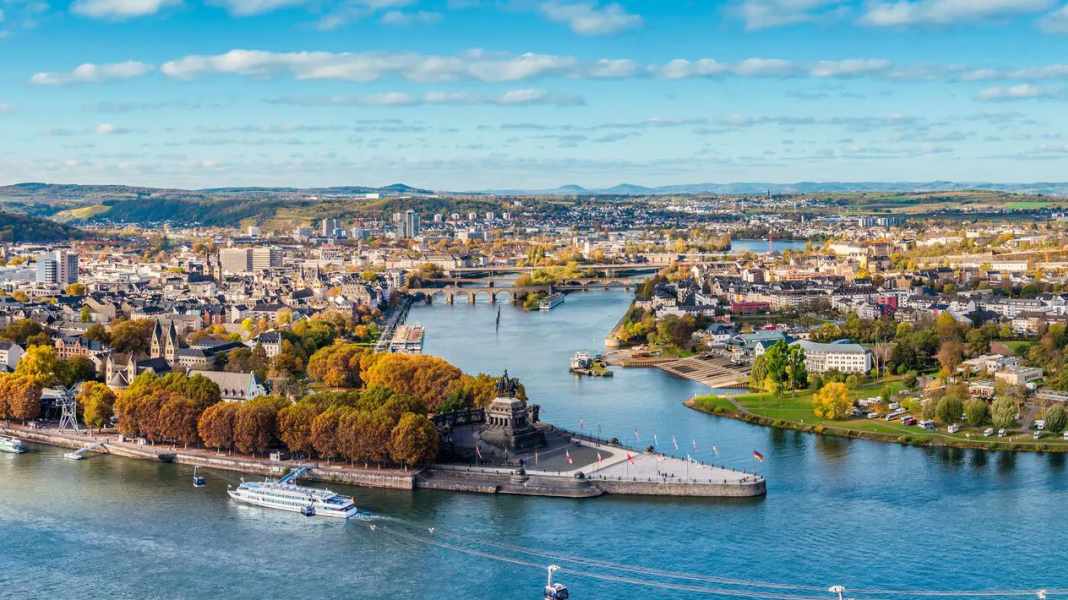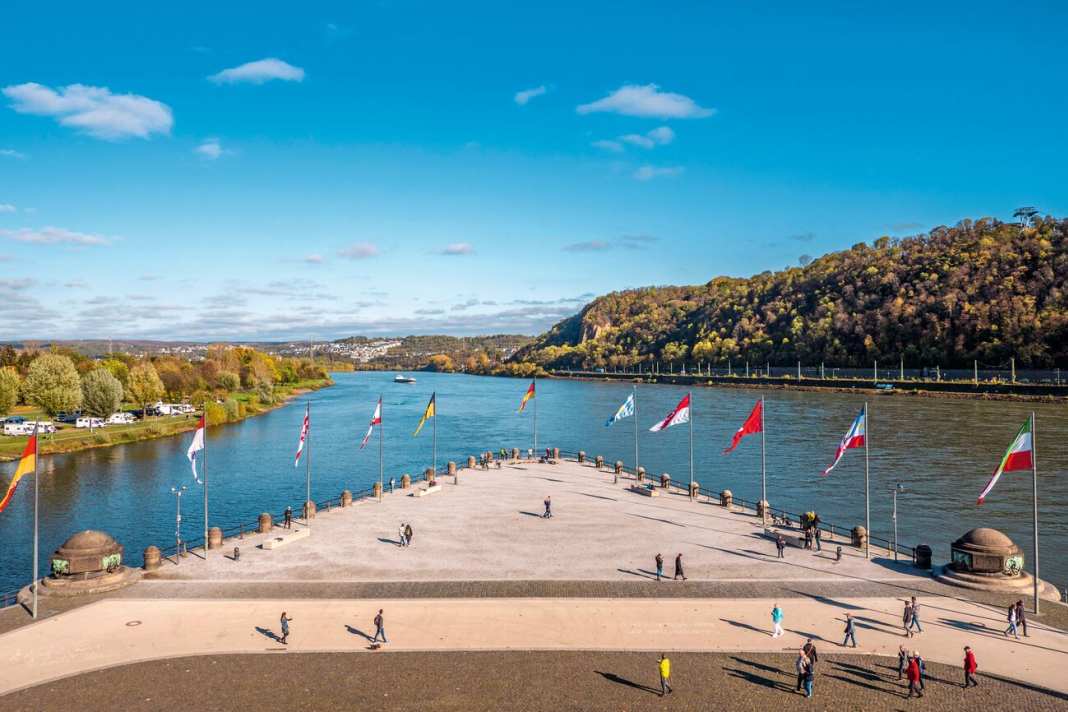
People have always come together where the Moselle flows into the Rhine, which is why Koblenz is one of the oldest cities in Germany. There were already settlements here in the Stone Age. The Romans also set up their military camp Castellum apud Confluentes here to secure the waterways. More than 2000 years later, the waterways still play an important role on one of the busiest waterways in the world. In addition to the economic aspect, leisure boating is also an important factor. Around Koblenz there are a large number of water sports clubs with landing stages on the Rhine and Moselle. There are more in both directions just a few kilometres further along the river. The Lahn can be explored to the south, followed by the Yacht Club Vallendar to the north. Ideal for water sports enthusiasts who want to take a look around the region and take a few days to get to know the town. The old town in particular has a lot to offer. Whether it's gastronomy, museums, exhibitions or shopping, Koblenz never gets boring. And a fortress with an impressive history is literally on top.
Impressions from Koblenz:






The fortress
The location alone has made for a very eventful history. The Ehrenbreitstein fortress complex towers above the town opposite the mouth of the Moselle. The roots of this historic military monument go back to a castle built around the year 1000, which was replaced by a fortification in the 16th century. This was blown up by French troops in 1801. After Frederick William III gave the "order to refortify the city of Coblenz and the Ehrenbreitstein fortress" in 1815, the current building for the Prussian army was constructed from 1817 onwards and has been a UNESCO World Heritage Site since 2002, like many other buildings in the city. The Middle Rhine Valley was secured from here until 1918. After its construction, the fortress was considered impregnable and is one of the largest fortifications in Europe. A visit is not to be missed. Guided tours with different themes are offered.
Those who are more interested in the breathtaking view from the 180 metre high Koblenz site will also get their money's worth. Since 2011, when the Federal Horticultural Show was held here on the neighbouring site, a cable car has been installed connecting the western bank of the Rhine with the site. The view from the ride across the Rhine alone makes it worth using. A combined ticket with admission to the fortress is recommended, as this is the only way to get to the viewing terrace with the best view over the city. The building complex also houses the Koblenz State Museum with various exhibitions.
Marinas and charters
Leisure captains are spoilt for choice in Koblenz, as there are a large number of landing stages in the city area. Probably the best known is the Kaiser Wilhelm Rhine Marina ( www.rhein-marina.de ) in Ehrenbreitstein harbour at Rhine kilometre 591.4 with a view of the mouth of the Moselle. A little upstream on the left bank at kilometre 589.2 is the Yacht Club Rheinlache Koblenz e. V. ( www.yachtclubrheinlache.de ), which also has moorings for guests. Directly next to it is the Wassersport-Club Koblenz e.V. with guest berths.
For further mooring options, you must turn into the Moselle, where craning is also possible. The jetties of the Segel- und Motor-Yacht-Club Koblenz e.V. ( www.smc-koblenz.de ) and the Yacht-Club Rhein-Mosel e.V. ( www.ycrm.de ) awaits guests. This is immediately followed by the Grühn water sports centre with its own marina ( www.wassersportzentrum.com ). Here you will find a complete service and guest facilities. This is followed by Bootservice Rörig GmbH in the Koblenz-Güls district ( www.bootsservice-roerig.de ) with full service and its own harbour on the Moselle. Although the journey into the city is a little long, the harbour is interesting for board sports enthusiasts, as it is the home of the Waterski-Club-Koblenz e.V. ( www.wasserskiclub-koblenz.de ), which offers 200 waterskiing trips with a Ski Nautique. Chartering is also possible. Tomko-Yachtsport ( www.tomko-yachtsport.de ) offers the motor yacht "Suerte", a steel displacement yacht of the type Marvis 1060, from Koblenz.
Deutsches Eck, banks of the Rhine and Electoral Palace
A walk along the Rhine promenade, which was redesigned for the 2011 Federal Horticultural Show, is a must when visiting Koblenz. Here, too, you can walk along paths steeped in history. The German Corner at the mouth of the Moselle is probably the most significant. The name goes back to knights of the Teutonic Order.
The wedge-shaped promontory is known as Deutscher Ordt, later Deutsches Eck, after a donation at the beginning of the 13th century of part of the Basilica of St Castor, which still stands here today. In 1891, Emperor Wilhelm II decided to erect a monument to his grandfather, the late Emperor Wilhelm I, in honour of the unification of Germany. To this end, today's headland, including the forecourt and the current riverside promenade, was heaped up at the mouth of the Moselle. Following its destruction in the Second World War, the monument was reconstructed in 1993. A walk along the promenade leads past the Deutschherrenhaus and the valley station of the cable car to the fortress on the opposite bank.
Soon the Prussian government building comes into view, which was built in 1902 and today serves as the headquarters of the Bundeswehr Procurement Office (BAAINBw). On the banks of the Rhine stands the Pegelhaus, a former crane from the 17th century that now houses a restaurant. This is followed by the Electoral Palace, built at the end of the 18th century by the Archbishop and Elector of Trier, which was rebuilt in the early 1950s after being destroyed in the war. The palace park and gardens were redesigned as part of the Federal Garden Show. If you now want to take a break, you can treat yourself to a gastronomic stop in the wine village below.
The half-timbered buildings were erected in 1925 for an imperial exhibition dedicated to German wine.
Hospitable old town
Hospitality is also very important in the old town, which dates back to Roman times. The fortifications were only removed in 1890. After severe war damage was repaired, the town centre has been restored to its former glory. There are five churches to visit, as well as squares with fountains and numerous restaurants and pavement cafés. On nearby Münzplatz, the baroque Old Mint is the only remaining building from this period, the mint master's house of the electoral mint.
Next to it is the Florinsmarkt with the Florinskirche from the 12th century. The medieval Old Department Store and the Schöffenhaus as well as the baroque Bürresheimer Hof are reconstructions of the originals that were destroyed in the war. A collection of buildings with striking oriels is known as the Four Towers. Three of them were reconstructed in the 1950s and 1960s following severe damage. Only the house from 1690 at Marktstraße 1 is still standing. Görresplatz with its fountain and history column, which tells the story of the city, is also lively and has numerous restaurants.
Culture and shopping
The central square is quite different: before the Second World War, half-timbered buildings stood here that fell victim to an air raid. It is not historical, modern architecture dominates. With the Forum Mittelrhein, a business centre was opened on Zentralplatz in 2013, which also houses the Forum Confluentes, a centre for art and culture that houses the Middle Rhine Museum and the tourist information office. The museum houses a permanent exhibition of paintings and sculptures from the Middle Ages to contemporary art. There are also regular special exhibitions with changing themes. A visit to Koblenz therefore has many facets and remains very varied even if you stay for several days.
Precinct information
The precinct
According to the SpFV from 2017, the Rhine may only be navigated with engines up to 3.68 kW (5 hp) without a licence. On the Moselle, on the other hand, up to 11.03 kW (15 hp) are permitted. Boats with more powerful engines require an inland boating licence. The Rhine and Moselle are heavily used by commercial shipping, and there are also a large number of excursion boats in Koblenz, so special care must be taken.
Navigation
Navigation is unproblematic by day and night. The fairways are buoyed and lighted. The shore areas are well lit. The current must be taken into account in both waters.
Nautical literature
Territory guide: "The Rhine, from the Rhine Falls to the North Sea and the IJsselmeer". By Manfred Fenzl. 208 p., 289 photos and illustrations, hardcover, format 21.6 x 30.3 cm; 59.90 euros. ISBN 978-3-667-12160-8. www.delius-klasing.de

